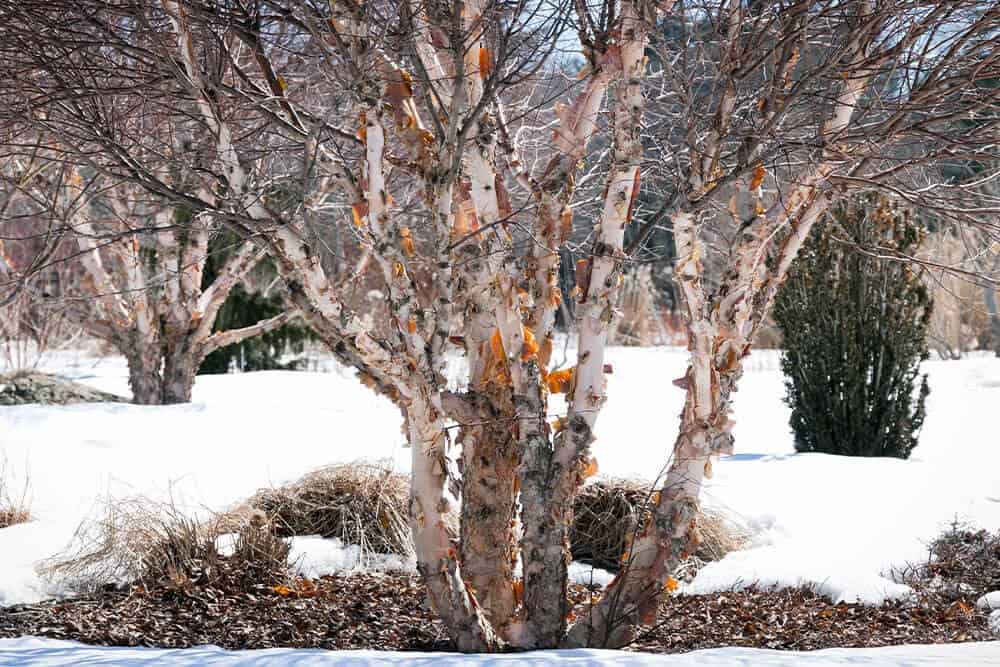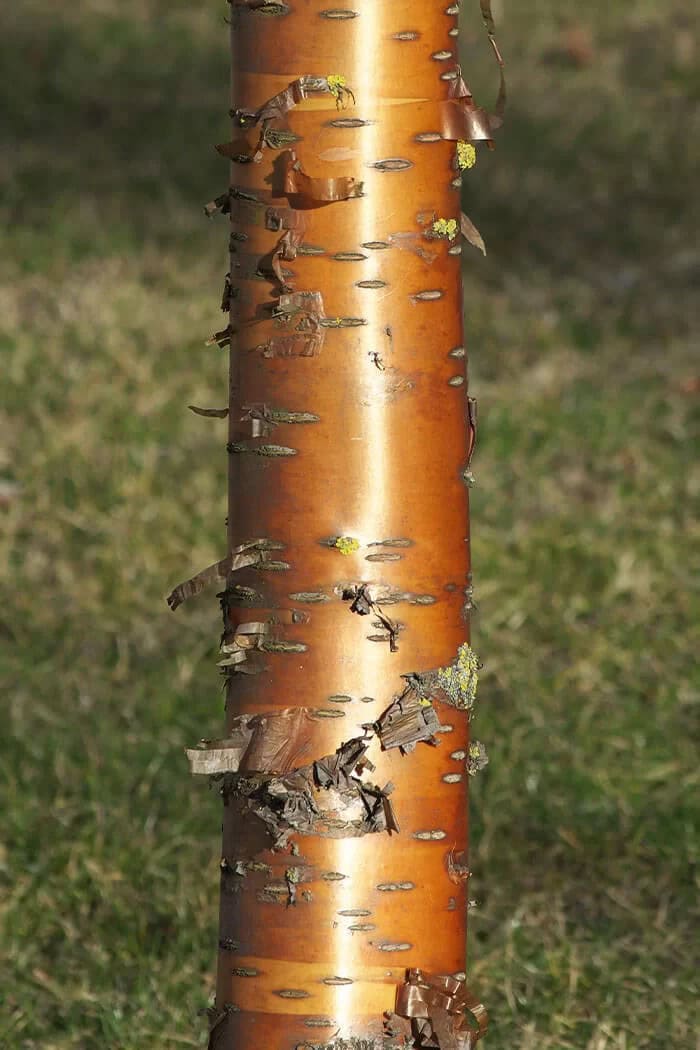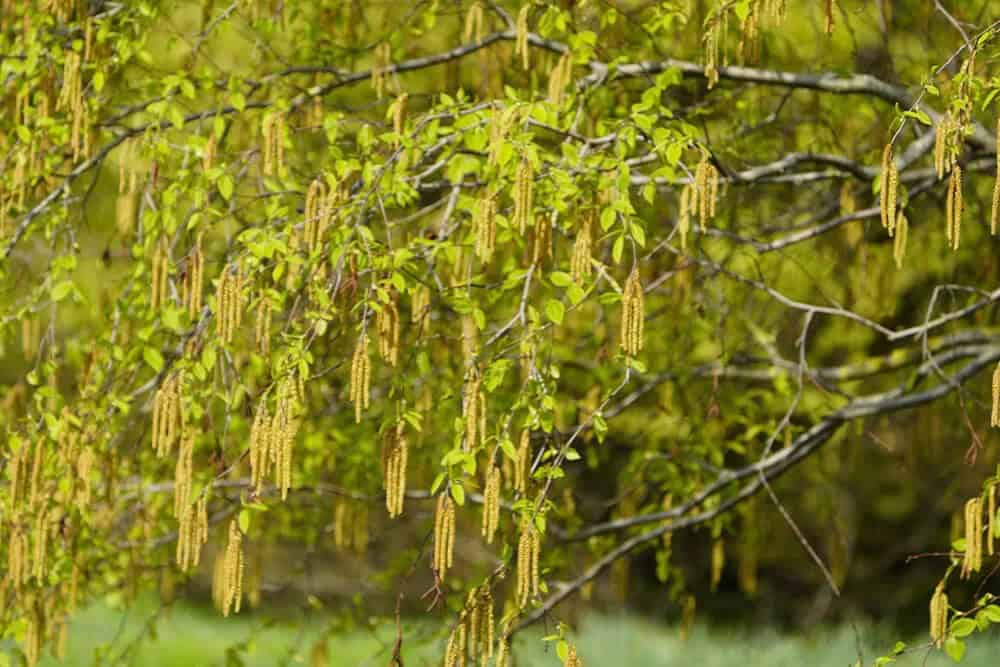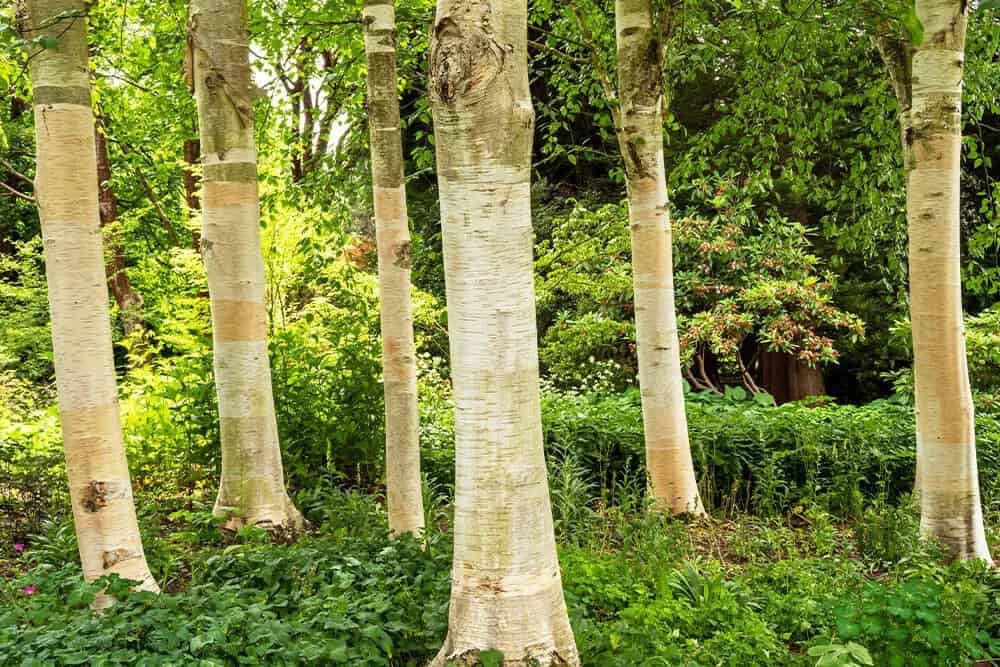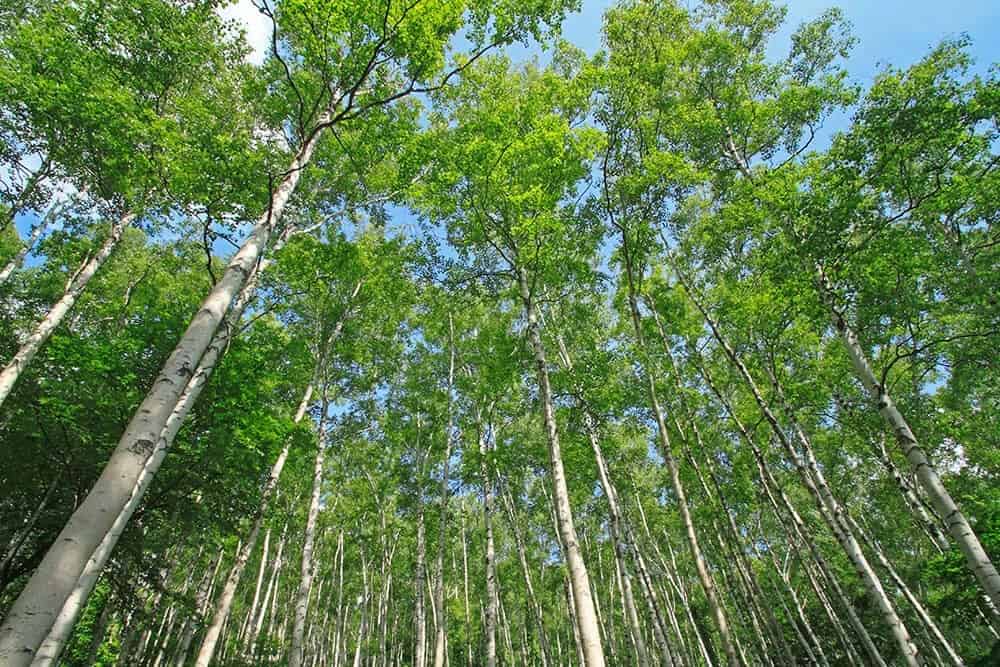The allure of birch trees lies not only in their striking natural beauty but also in their adaptability to various garden sizes. While some species, like Paper Birch (Betula papyrifera), boast bold white peeling bark that provides year-round visual interest, others thrive in smaller spaces. For instance, Young’s Weeping Birch (Betula pendula Youngii) grows between 6 and 12 feet tall, making it an ideal choice for compact gardens.
In contrast, Himalayan Birch (Betula utilis) can reach heights of 30 to 50 feet, while Japanese White Birch (Betula platyphylla ‘Japonica’) falls somewhere in the middle. Meanwhile, Dwarf Birch (Betula nana), a shrub native to arctic tundra landscapes, grows remarkably small at just 6 inches to 3 feet tall. As we explore our selection of 11 captivating birch tree varieties, their unique attributes will come into focus, showcasing the diversity and charm that these trees bring to any garden.
Key Takeaways
Birch trees exhibit a remarkable combination of traits – they thrive as fast-growing, yet surprisingly short-lived species. While some may think they’re finicky about moisture levels, the truth is that many Birches actually prefer environments with plenty of water. In fact, certain varieties like Bog Birch (Betula pumila) and Water Birch (Betula occidentalis or Betula fontinalis) are particularly drawn to soggy sites.
Despite their thirst for hydration, these trees have a profound symbolic significance, representing new beginnings and often serving as pioneer species in natural forest ecosystems. With over 60 species within the Betula genus, it’s no wonder that Birches can be found in a wide range of settings, from towering giants in mature forests to carefully curated landscape features in smaller gardens.
11 Interesting Types of Birch Trees Symbolizing New Beginnings in the Landscape
Paper Birch (Betula papyrifera)
Paper Birch, a stalwart of northern landscapes, thrives in USDA hardiness zones 2 to 7, where it can be found growing in moist, well-drained soils. As one of the first trees to unfurl its leaves each spring, Paper Birch showcases delicate, 4-inch-long catkins that droop from its multi- or single-trunked branches. The tree’s new foliage is a vibrant green, maturing into dark, glossy leaves that reach 2-to-4 inches in length.
As the seasons progress, Paper Birch develops a rounded oval shape with open branching, reaching mature heights of 45 to 100 feet. Its dappled shade makes it an attractive choice for gardeners seeking to create a peaceful atmosphere. Beyond its aesthetic appeal, Paper Birch plays a vital role as a host plant for emerging butterflies like the Eastern Tiger Swallowtail, making it an excellent selection for butterfly and pollinator gardens.
The tree’s affinity for moist sites makes it particularly well-suited for rain gardens, where it can add a pop of color and interest to the winter landscape. And let’s not forget its famous papery bark, which peels away in brilliant white layers, providing a stunning display of winter interest.
Silver Birch (Betula pendula)
Silver Birch, also known as European White Birch or Weeping Birch, is a charming species that originates from Europe and Asia. Its weeping habit has led to the development of numerous ornamental cultivars, ranging in size from large to small. This versatile tree thrives in USDA hardiness zones 2 through 7, where it prefers moist to wet well-draining soils and full sun. As a young tree, it forms a pyramidal crown that matures into an oval or rounded shape.
The species’ leaves are 1-3 inches long and have a tapered oval shape, featuring serrated edges. Some cultivars, such as Betula pendula ‘Filigree Lace’ and Betula pendula ‘Laciniata’, boast deeply cut leaves that add textural interest to the garden. In spring, the tree produces 2 ½ inch yellowish catkins that droop from its pendulous branches.
Cutleaf Weeping Birch (Betula pendula ‘Gracilis’)
The Cutleaf Weeping Birch (Betula pendula) is an exceptional cultivar that brings a dramatic presence to any garden. Its unique character stems from the striking contrast between its upright, pyramidal form and the long, fine branches that weep downwards like nature’s own work of art. Reaching maturity at 40-50 feet tall, this tree demands attention in both spring and fall when it showcases vibrant catkins and warm yellow foliage respectively.
But what truly sets it apart is the intricate beauty of its leaves. Delicately dissected with saw-tooth edges, they have a lacy quality that adds to the overall enchantment of the tree’s sweeping branches. It’s as if this tree has stepped straight out of a fairy tale and into your garden.
Young’s Weeping Birch (Betula pendula ‘Youngii’)
When considering planting a Silver Birch (Betula pendula) or one of its captivating cultivars, but struggling with limited space, the Young’s Weeping Birch (Betula pendula ‘Youngii’) could be the perfect solution. This compact version of European White Birch or Silver Birch (Betula pendula) offers all the flair on a smaller scale, reaching maturity heights of 6 to 12 feet tall.
Its intensified weeping habit adds an extra layer of drama, while its ability to thrive in warmer climates makes it suitable for USDA hardiness zones 3 to 9.
River Birch (Betula nigra)
River Birch, also known as Black Birch (Betula nigra), stands out among its peers as a versatile and resilient tree species. Native to eastern North America, this deciduous tree is characterized by its striking bark, which features a range of colors including salmon, red, pink, and brown that gradually exfoliates to reveal lighter hues underneath. Reaching heights of 40 to 70 feet and living for 40 years or more in optimal conditions, River Birch thrives in USDA hardiness zones 4 to 9.
One of its notable advantages is its natural resistance to the bronze birch borer (Agrilus anxius), a common pest that affects many other birch species. Additionally, River Birch exhibits remarkable drought tolerance compared to others in its genus, making it an attractive choice for landscaping and gardening. Furthermore, the cultivar Dura Heat has demonstrated exceptional heat and drought resilience, further solidifying River Birch’s reputation as a dependable and low-maintenance tree option.
Water Birch (Betula occidentalis or Betula fontinalis)
Water Birch (Betula occidentalis) is a standout selection for rain or bog gardens. Its ability to thrive in consistently moist to wet soils makes it an ideal choice for planting along streambanks, ponds, and lowlands. As a multi-trunked tree or tall shrub, Water Birch forms a striking display when planted in groups. One of its most notable features is the glossy, black to reddish-brown bark adorned with distinctive horizontal stripes or lenticels.
Young trees tend to grow upright with open branching that later becomes more sprawling as they mature. While it can reach heights of up to 40 feet, Water Birch typically tops out at 15-30 feet tall. Native to western North America, this hardy species plays a crucial role in its ecosystem as a food source and material for beavers’ lodges. It’s also tolerant of USDA zones 2 to 6, making it a reliable addition to many landscapes.
Bog Birch (Betula pumila)
Bog Birch (Betula pumila), a diminutive yet adaptable tree, thrives in environments where moisture is abundant, tolerating clay and alkaline soils with ease. Native to North America, this hardy species can be found in USDA zones 2 to 9. Also known as American Dwarf Birch, Bog Birch exhibits a clumping growth habit, reaching heights of only 5-10 feet. Its leaves boast coarse, sharp teeth on their edges, with upper surfaces a deep green and lower surfaces a lighter hue.
The fan-shaped leaves themselves have rounded tips and taper towards the base, resembling a wedge shape. As its branches mature, they lose their initial fuzziness, taking on a rich maroon to reddish-brown color.
Cherry Birch (Betula lenta)
Cherry Birch (Betula lenta), also known as Sweet Birch, hails from eastern North America, where it is an endangered species in its northernmost range. This adds a layer of importance to cultivating this stunning tree. Its role as a host tree for various moths and butterflies, such as the Mourning Cloak, Dreamy Duskywing, and Eastern Tiger Swallowtail, cannot be overstated.
The seeds provide sustenance for birds seeking refuge in its branches, while deer, moose, and rabbits also benefit from its bounty.
Reaching heights of 40 to 70 feet, Cherry Birch is a hardy tree that thrives in USDA zones 3 to 8. Its natural resistance to the Bronze Birch Borer is just one aspect of its durability. The tree’s attractive features include its shiny red-brown bark and vibrant yellow fall foliage, which add visual interest to any landscape.
Yellow Birch (Betula alleghaniensis)
This stunning Yellow Birch Tree (Betula alleghaniensis) boasts an impressive yellow-bronze peeling bark, which gives it its name. Its autumn foliage is equally striking, displaying a vibrant bright yellow hue. Notably, the tree’s catkins grow in clusters from the branch tips, measuring 2 ½ to 4 inches in length. The leaves themselves are dull dark green, featuring toothed margins and pointed tips.
A long-lived species native to North America, Yellow Birch is an exemplary provider of sustenance and shelter for a diverse array of songbirds, small mammals, butterflies, and pollinators. As a single-trunk tree, it can grow up to 50 to 80 feet tall. With hardiness ratings in USDA zones 3 to 7, it proves an excellent shade tree choice, thriving in full sun to part shade conditions and fertile, well-draining sandy loam soil.
Himalayan Birch (Betula utilis ‘jacquemontii’)
With its striking white bark, Himalayan Birch (Betula utilis) is a winter landscape standout. The tree’s open branching and pyramidal shape showcase its elegant form, while the peeling bark adds an admirable touch. As spring arrives, long catkins droop from the branches, followed by fantastic fall colors that further emphasize this tree’s ornamental appeal. Native to Nepal in Asia, Himalayan Birch is a hardy species tolerating USDA zones 4 to 7.
However, it can be stressed in drought-prone or warm climates, making it susceptible to pests like Bronze Birch Borer. To thrive, Himalayan Birch requires consistent moisture, much like its birch tree relatives. Cool climates are also ideal for this species. Beyond its natural charm, notable cultivars have been developed to highlight the tree’s bark color, size, shape, and growth habit.
Notable examples include ‘Fascination’, ‘Forest Blush’, and ‘Park Wood’, all of which have earned the Royal Horticultural Society’s Award of Garden Merit.
Japanese White Birch (Betula platyphylla ‘Japonica’)
The Japanese White Birch (Betula platyphylla ‘Japonica’) is a refined addition to any landscape in cooler climates. Its ability to tolerate shade makes it an attractive option for gardens with limited sunlight. However, this tree is susceptible to pests such as the Bronze Birch Borer, particularly when under stress. It’s essential to choose a location that provides sufficient moisture and avoids extreme heat.
Ideally situated in an eastern or northern exposure, this variety of birch tree can grow up to 40-50 feet tall and thrive in USDA hardiness zones 3-8. For gardeners in warmer and drier regions, the River Birch (Betula nigra) may be a more suitable choice.
Frequently Asked Questions About Birch Trees
What is the most common type of birch tree?
Silver Birch (Betula pendula) boasts remarkable ornamental value, with its striking beauty captivating vast areas across Europe and Asia. The cultivars that have emerged from Betula pendula, such as the Cutleaf Weeping Birch (‘Gracilis’) and Young’s Weeping Birch (‘Youngii’), showcase the species’ incredible versatility.
Interestingly, Paper Birch (Betula papyrifera), native to North America, shares many of Silver Birch’s alluring features, including its iconic white bark, lustrous leaves with serrated edges, and vibrant golden fall hues.
What is the most beautiful birch tree?
While it’s subjective, a healthy Birch Tree will showcase its unique features depending on your perspective. Among nursery favorites, Cutleaf Weeping Birch (Betula pendula ‘Gracilis’) stands out with its captivating weeping habit, intricately serrated leaves, striking white bark, and golden fall hues that exude a sense of natural splendor. However, it’s not the only contender for beauty.
Paper Birch (Betula papyrifera), a North American native, boasts outstanding peeling white bark and plays a vital role in supporting local bird and wildlife populations, making its natural charm unparalleled. Ultimately, as the old adage goes, ‘beauty is in the eye of the beholder,’ leaving the interpretation up to individual perspectives.
Are there birch trees in Europe?
Silver Birch (Betula pendula), also referred to as European White Birch, boasts a vast natural range stretching from the Atlantic to eastern Siberia, solidifying its position as the most commercially significant broadleaved tree species. This revered tree has a rich history in Europe, with roots dating back to Roman mythology where it was employed for purification rituals. Furthermore, Birch Trees are known to leaf out early in the spring, often preceding other species in this process.
Notably, they were also among the first tree species to colonize areas after the glaciers receded during the last ice age. These unique characteristics have led the Celts to associate Silver Birch with symbolism of new beginnings, renewal, and purification.
Is an aspen a birch?
While they may resemble each other at first glance, aspen trees have a distinct genetic connection to poplar trees rather than the betula genus. This familial bond is evident in their shared affinity for full sun and moist environments. In fact, both aspens and poplars can often be found growing together, thriving in these optimal conditions. Interestingly, native species of aspen found in North America include Trembling Aspen (Populus tremuloides) and Bigtooth Aspen (Populus grandidentata).
What is the difference between birch and aspen trees?
While aspen and birch trees can be challenging to distinguish in a forest setting, there is a simple way to tell them apart: examining their bark. One of the most striking differences between the two species is the color and pattern of their bark. Aspen trees typically have pale green or grey bark featuring dark, eye-like markings, whereas birch trees are characterized by horizontal stripes or lenticels. Furthermore, the leaves of these trees also provide a key to identification.
Aspens boast smooth, rounded, heart-shaped leaves, while birches sport serrated or toothed margins and triangular, pointed leaves.
Is an alder a type of birch?
While birch trees belong to the Betula genus within the larger family of plants known as Betulaceae, alder trees are part of a distinct genus – Alnus. Although both families share some similarities, such as toothed leaves and drooping catkins, they remain separate categories. You could say that alders and birch trees have a familial connection, with the latter being a member of the same botanical family.
11 Iconic Types of Birch Trees for Year-Round Garden Interest
When selecting a Birch Tree for your garden, the sheer variety can be both exciting and overwhelming. Certain types, such as Water Birch (Betula occidentalis) and Bog Birch (Betula pumila), excel in waterlogged environments or bog-like settings. On the other hand, River Birch (Betula nigra) stands out due to its natural resistance to Bronze Birch Borer infestations, combined with heat and drought tolerance that surpasses many other Birches.
This remarkable tree also boasts attractive features like serrated leaves, unique bark patterns, and vibrant golden fall foliage, making it a valuable addition to your garden throughout the year.




